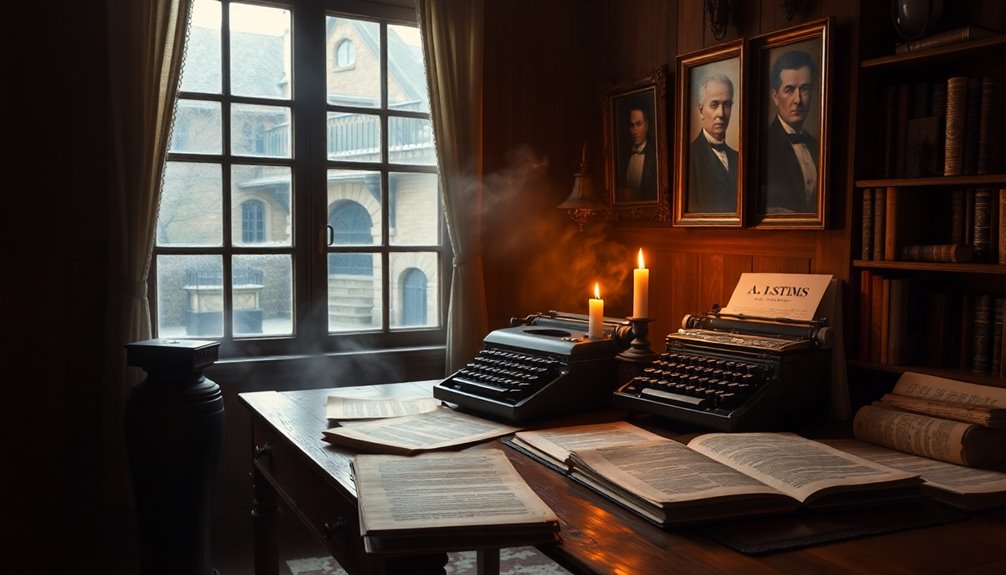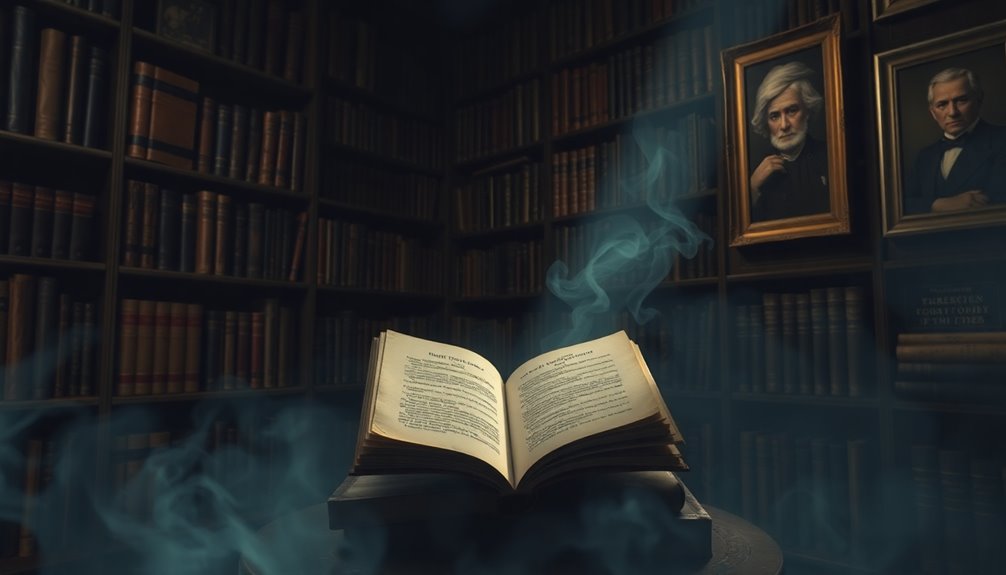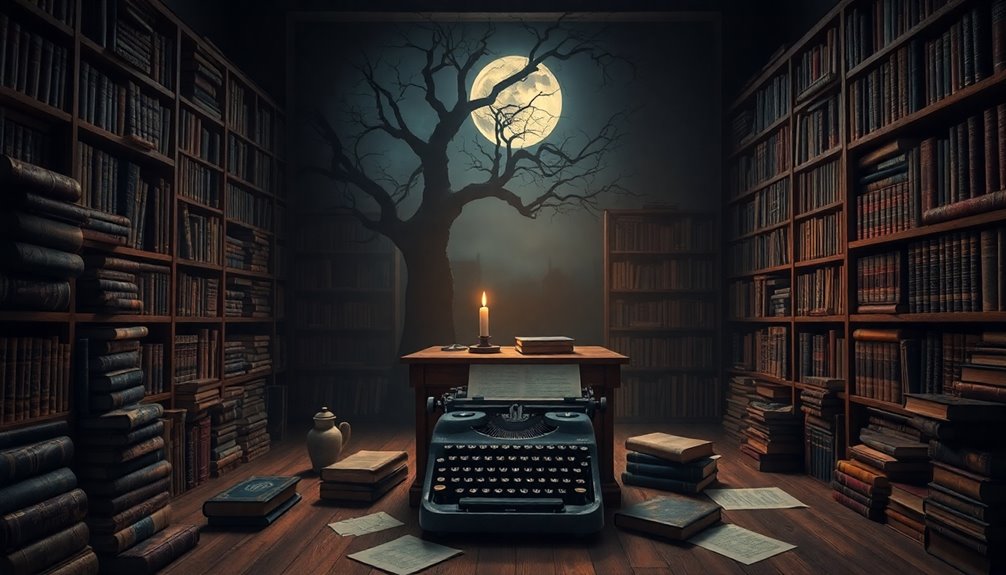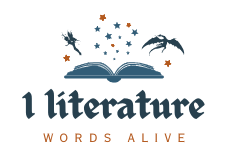Exploring the work of iconic ghost story authors brings you face to face with the eerie and the extraordinary. From A. J. Alan's suspenseful narratives to Grant Allen's supernatural reflections, each writer has a unique voice. Sabine Baring-Gould intertwines hymns and folklore, while Nugent Barker challenges your perceptions of reality. The Benson brothers, Algernon Blackwood, Henry James, and Elizabeth Gaskell each contribute layers of psychological depth and social commentary, leading you to profound mysteries of the human experience.
The Haunting Prose of A. J. Alan

A. J. Alan masterfully crafts ghost stories that linger long after you've heard them. His supernatural tales, popularized through riveting radio broadcasts in the 1920s, showcase a unique narrative style that blends suspense with a conversational tone.
You'll find yourself drawn into ordinary settings that transform into eerie landscapes, where the mundane becomes unsettling. Alan's ability to weave humor into horror makes his stories accessible, allowing a broader audience to embrace the chilling atmosphere he creates. His work, much like the personal narratives shared by successful Australian women, highlights the importance of courage and determination in confronting fears and challenges. The complexity of his narratives mirrors the intricate relationships found in family dramas, revealing the many layers of human emotion.
Collections like "Good Evening, Everyone" highlight his talent for engaging storytelling, echoing the personal narrative and local legend that continue to influence contemporary ghost stories. With Alan, the supernatural feels relatable yet haunting, inviting you to explore the unknown. His work resonates with themes of courage and resilience, much like the strong female protagonists in sci-fi who face the unknown and challenge traditional narratives.
Grant Allen and the Supernatural Mystique
When you explore Grant Allen's life, you'll find early influences that shaped his unique perspective on the supernatural.
His notable works, like "Pallinghurst Barrow," showcase a blend of humor and horror, reflecting the Victorian obsession with the unknown. The exploration of civilization vs. savagery in literature during this period often mirrored societal anxieties and fears, much like Allen's narratives. Additionally, the atmosphere of Manderley in *Rebecca* serves as a prime example of how settings can become characters themselves, enhancing the overall mystery.
As you examine the themes in his stories, you'll see how they challenge reality and engage with societal fears in intriguing ways. Additionally, the fascination with the supernatural during his time can be linked to gender identity confusion, which often led to societal anxieties reflected in literature.
Early Life Influences
Those fascinated by the supernatural often find themselves drawn to Grant Allen, a figure whose early life considerably shaped his literary pursuits. Born in Canada in 1848, you'd notice how his diverse upbringing fueled his interest in science and literature.
This blend became essential in exploring supernatural themes, especially during the Victorian era, when ghost storytelling thrived. His fascination with spiritualism, a popular movement in the late 19th century, pushed him to examine the boundary between life and death.
In works like "Strange Stories," he masterfully combined the eerie with the familiar, allowing readers to relate to his ghostly tales. Through this innovative approach, Allen left a lasting legacy, influencing future authors in the supernatural genre.
Notable Works Overview
Building on Grant Allen's formative experiences, his notable works reveal a fascinating interplay between the supernatural and scientific inquiry.
As you explore his ghost stories, like "Pallinghurst Barrow" and "Strange Stories," you'll notice how he masterfully blends psychological horror with traditional horror genre elements.
Allen's writing reflects the late Victorian era's obsession with the occult, capturing the cultural anxieties of his time.
His narratives often evoke local folklore and explore the uncanny, creating a rich tapestry of supernatural themes that challenge rational thought.
Themes in Stories
Mystique permeates Grant Allen's ghost stories, where the supernatural intertwines seamlessly with the natural world. His themes often explore life after death, reflecting Victorian anxieties about the unknown.
You'll find that his horror stories challenge reality's boundaries, inviting you to question what lies beyond the visible world. Supernatural elements, grounded in local folklore, enhance the eerie atmosphere, making the narratives resonate culturally.
Allen's intricate plots not only entertain but also provoke thought, emphasizing psychological depth and the exploration of human consciousness. Through these layers, his stories become hauntingly memorable, pulling you into the delicate interplay between science and the supernatural.
You can't help but feel the tension of uncertainty that defines his unique storytelling style.
Sabine Baring-Gould: Hymns and Ghostly Tales
When you explore the literary contributions of Sabine Baring-Gould, you'll find a fascinating blend of hymns and ghostly tales. His stories are steeped in folklore, using supernatural elements to raise moral and existential questions. This unique combination not only captivates readers but also highlights the rich traditions of rural England. Furthermore, his work reflects the importance of marginalized individuals' contributions to cultural narratives that often go unrecognized, showcasing how hidden heroes can provide fresh perspectives on the societal context of his time. Additionally, his narratives echo the complex family dynamics found in literature, illustrating how personal relationships shape the human experience.
Literary Contributions and Themes
Though often celebrated for his hymns, Sabine Baring-Gould's literary contributions extend deeply into the domain of ghost stories, where he skillfully weaves folklore and personal experience into his narratives.
His works, such as "A Book of Ghosts" and "A Happy Release," reflect a fascination with the supernatural, blending Gothic literature with local legends.
- Engaging storytelling style that resonates with readers
- Exploration of moral and ethical themes
- Rich incorporation of cultural folklore
- Connection to Victorian societal norms and fears
- Prolific output with over 140 books
Baring-Gould's ghost stories not only entertain but also provoke thought about death and the afterlife, making him a pivotal figure in both ghostly and Victorian literature.
Folklore and Supernatural Elements
While exploring Sabine Baring-Gould's ghost stories, you'll notice how deeply intertwined folklore and supernatural elements are in his narratives.
His collection, "A Book of Ghosts," showcases local legends and eerie tales that breathe life into cultural heritage. You'll find that Baring-Gould's narratives often reflect the community's beliefs surrounding ghosts, enhancing their chilling atmosphere.
He skillfully weaves hymns and religious themes into his writing, merging spirituality with the supernatural to deliver profound moral undertones. By advocating for the preservation of local folklore, he emphasizes its importance to community identity.
His extensive research not only shaped ghost stories in English literature but also highlighted the significance of these tales in understanding our shared cultural heritage.
Nugent Barker's Short Stories of the Unseen

As you explore Nugent Barker's short stories, you'll encounter a fascinating blend of the eerie and the macabre that captures the essence of the unseen.
His collection, "Written With My Left Hand," showcases ghost stories that investigate deep into the supernatural while reflecting societal anxieties of the early 20th century. Notably, the intricate plotting in his tales mirrors the complexity found in contemporary historical mysteries like The Daughters of Night, which also delves into societal themes. This interplay of societal concerns and supernatural elements resonates with the notion of collective wrongdoing, emphasizing the impact of unseen forces on human lives.
Barker's distinctive narrative style intertwines wit with unsettling atmospheres, compelling you to confront human psychology and the fear of the unknown.
- Engaging storytelling that captivates
- Themes of the supernatural and unseen
- Insight into human psychology
- Unsettling yet entertaining narratives
- Influential contributions to ghost story genre
Barker's work remains a significant touchstone in the landscape of supernatural fiction, inviting readers to question reality itself. Furthermore, his stories often evoke a dark and suspenseful atmosphere that grips readers, enhancing the overall tension throughout his narratives.
The Benson Brothers: A Legacy of Ghost Stories
The Benson brothers carved out a unique niche in ghost storytelling with their distinctive writing styles and rich themes. You'll find that Edward's moral explorations, Arthur's interplay of the living and dead, and Robert's religious undertones create a fascinating tapestry of the supernatural. Their influence on literature continues to resonate, shaping how we think about ghost stories today. Additionally, their works echo themes of obsession, jealousy, and power struggles, which are central to many classic ghost narratives. This intertwining of manipulation and deception enhances the chilling atmosphere often found in their tales. Furthermore, the collective action depicted in their stories often reflects the courage needed to confront one's inner demons and societal oppressions.
Distinctive Writing Styles
Although each of the Benson brothers brought their own flair to ghost storytelling, you can easily identify their distinctive styles through the themes and tones they employed.
Their works showcase a rich tapestry of ghost stories, often incorporating supernatural elements and varied narrative styles.
- Edward Frederic Benson: Blends humor with haunting, creating engaging contrasts.
- Arthur Christopher Benson: Explores the inescapability of the past and mortality.
- Robert Hugh Benson: Intertwines Catholic perspectives with spiritual encounters.
Unique reflections of personal experiences shape their narratives.
Collective influence on the evolution of early 20th-century ghost tales.
Together, the Benson brothers not only crafted enthralling ghost stories but also left a lasting impact on future writers in the genre.
Themes and Motifs
Ghost stories by the Benson brothers resonate with profound themes and motifs that explore the complexities of human experience.
Edward Frederic Benson's tales often probe into the psychological aspects of fear, weaving haunting atmospheres that reflect Victorian anxieties. His moral explorations highlight the intricate dance between human frailty and the supernatural.
Arthur Christopher Benson infuses satire into his narratives, tackling existential themes and the nature of life and death, making you reflect on your own beliefs.
Meanwhile, Robert Hugh Benson's works, shaped by his Catholic background, investigate spiritual themes, contemplating faith, the supernatural, and the afterlife.
Together, their contributions enrich the domain of supernatural fiction, offering you deep insights into the human condition through their ghost stories.
Influence on Literature
While many authors have dabbled in the ghost story genre, the Benson brothers stand out for their profound impact on literature. Their collective works have shaped the way we perceive ghost stories today, infusing them with humor, morality, and spiritual themes.
- Edward Frederic Benson's humor mixed with supernatural elements
- Arthur Christopher Benson's ability to craft eerie atmospheres
- Robert Hugh Benson's reflections on the afterlife from a Catholic viewpoint
- Over 100 books that greatly advanced ghost storytelling
- A lasting influence on contemporary ghost stories in modern literature
Their unique styles and thematic depth not only defined early 20th-century ghost stories but continue to inspire writers, ensuring their legacy remains vibrant in the literary world.
Ambrose Bierce and the Satirical Supernatural
Ambrose Bierce masterfully intertwines satire with the supernatural, creating a unique blend that both entertains and provokes thought. His ghost stories aren't just eerie tales; they offer sharp commentary on human nature, revealing our follies with a satirical twist.
In his collection "Can Such Things Be," Bierce explores death and the afterlife through ironic wit, enhancing the psychological horror that seeps into his narratives. His keen awareness of life's grim realities, shaped by personal loss and trauma, adds depth to his work.
Algernon Blackwood's Weird Fiction Wonders

Algernon Blackwood's mastery of weird fiction invites you to explore the mystical and often unsettling domains of nature and the supernatural. His works, such as "The Willows" and "The Wendigo," blend psychological horror with elements of the occult, challenging you to confront deep existential fears.
As you investigate his stories, you'll discover:
- A profound connection between nature and the supernatural
- The concept of the occult detective
- Lyrical prose that evokes vivid imagery
- Themes of spirituality intertwined with horror
- An influence on later horror writers, including H. P. Lovecraft
Blackwood's ability to evoke terror through the natural world makes him a significant figure in early 20th-century horror literature, enriching the genre of weird fiction.
Henry James: The Psychological Ghost Story
Henry James stands out as a master of the psychological ghost story, weaving tales that explore deep into the human psyche.
His renowned work, "The Turn of the Screw," illustrates themes of perception and moral ambiguity, challenging you to question the reality of the supernatural.
Featuring unreliable narrators, James compels you to navigate the murky waters of truth and illusion.
His narratives probe into the complexities of human emotions, revealing how repression and desire shape our experiences.
The subtlety of his prose creates an atmosphere of dread, where the supernatural becomes a metaphor for psychological conflict.
Elizabeth Gaskell's Contributions to the Genre
Although often overshadowed by her male contemporaries, Elizabeth Gaskell made significant contributions to the ghost story genre, skillfully intertwining the supernatural with the pressing social issues of her time.
Her works, particularly "The Old Nurse's Story," showcase how domestic settings can enhance the eerie atmosphere of ghost stories. Gaskell's narratives often reflect societal fears and moral dilemmas, offering deep psychological insights into her characters.
- Blended supernatural with social commentary
- Explored themes of loss and memory
- Addressed class and gender issues
- Resonated with emotional and moral weight
- Contributed to the Victorian era's fascination with ghost stories
The Enduring Appeal of Ghostly Narratives
As you explore the world of ghostly narratives, you'll find their timeless appeal lies in the exploration of life's most profound mysteries: death, grief, and the unknown.
Ghost stories resonate deeply, thanks to iconic authors like M.R. James and Algernon Blackwood, who crafted haunting atmospheres and complex characters. Their works not only entertain but investigate psychological depth and societal issues, making them relevant for modern readers.
Additionally, the incorporation of folklore and local legends adds cultural depth, reflecting historical traumas and societal fears that captivate audiences.
This enduring appeal is further recognized in prestigious literary circles, with ghost stories even earning longlisting for the Booker Prize, solidifying their place in contemporary literature.
Conclusion
As you wander through the eerie landscapes crafted by these iconic authors, you can't help but feel their spectral whispers beckoning you closer. Each tale, like a ghostly TikTok video, captures a moment frozen in time, inviting you to experience the unexplainable. Their work reminds us that the uncanny never truly fades; it lingers in the shadows of our imagination, waiting for you to turn off your phone and listen to the stories that haunt us all.


